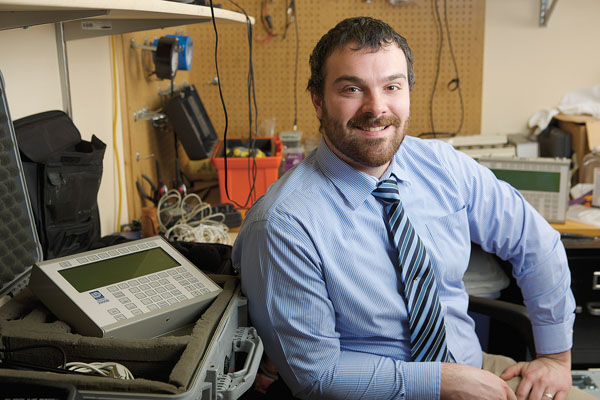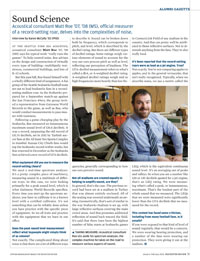Alumni Gazette
 TAKING MEASURE: Acoustical consultant Roe sits aside his spectrum analyzer, the complex machine he takes on the road to measure
various aspects of sound. (Photo: Stephen Brashear/AP Images for Rochester Review)
TAKING MEASURE: Acoustical consultant Roe sits aside his spectrum analyzer, the complex machine he takes on the road to measure
various aspects of sound. (Photo: Stephen Brashear/AP Images for Rochester Review)At the Seattle firm SSA Acoustics, acoustical consultant Matt Roe ’07, ’08 (MS) says his typical work “really runs the gamut.” To help control noise, Roe advises on the design and construction of virtually every type of building—multifamily residences, commercial buildings, and lots of K–12 schools. But this past fall, Roe found himself with a wholly different kind of assignment. A fan group of the Seattle Seahawks football team set out to lead Seahawks fans in a record-setting stadium roar. As the Seahawks prepared for a September match-up against the San Francisco 49ers, the group invited a representative from Guinness World Records to the game, as well as Roe, who would conduct measurements to pass muster with Guinness. Following a game-changing play by the Seahawks,
Roe measured an instantaneous maximum sound level of 136.6 decibels. It was a record, surpassing the old record of 131.76 decibels, set in 2011 by Turkish soccer fans at the Ali Sami Yen Sports Complex in Istanbul. Kansas City Chiefs fans would top the Seahawks record within weeks, but Roe returned in December as the Seahawks fans achieved a new record of 137.6 decibels.
What equipment did you use to measure the record-setting cheers?
We used a real-time spectrum analyzer. It’s a pretty complex piece of machinery, measuring sound in a multitude of different ways. In this case, we were looking primarily for a peak sound level, which is what Guinness World Records specifies. Every time you start up the spectrum analyzer, you have to calibrate it to a known level with a certified calibrator. It’s not something that can be reliably done unless you have practice with the specific piece of equipment. So we all train and practice with the equipment that we have in our office.
Does the peak sound level measurement reflect what laypeople might simply think of as volume?
Not exactly. The complicated thing about noise is that there are a lot of different ways to describe it. Sound can be broken down both by frequency, which corresponds to pitch, and level, which is described by the decibel rating. But there are different types of decibel ratings. Some ratings weigh various elements of sound to account for the way our ears process pitch as well as level, reflecting our perception of loudness. The 137.6-decibel measurement refers to what’s called a dbA, or A-weighted decibel rating. A-weighted decibel ratings weigh mid to high frequencies more heavily than low frequencies, generally corresponding to how our ears perceive sound.
Not all stadiums are created equally in helping to amplify sound, are they?
In general, that’s the case. The previous record had been set at a stadium in Turkey that was almost entirely enclosed. All of the seating was covered underneath an awning. Geometrically, that’s sort of similar to the way Seahawks Stadium is set up, with large reflective surfaces covering the main crowd areas. And that promotes additional reflection of sound back toward the field. It’s said that there have been the highest number of false starts at Seahawks games in CenturyLink Field of any stadium in the country. And that can pretty well be attributed to those reflective surfaces. Not to diminish anything from the fans. They’re also really loud.
It’s been reported that the record-setting roars were as loud as a jet engine. True?
Not exactly. You’re not comparing apples to apples, and in the general vernacular, that isn’t really recognized. Typically, when we describe noise, we use a metric called the LEQ, which is the equivalent continuous sound level. It’s an averaging out of peaks and valleys. So when you see a number like 120 or 130 decibels quoted for a jet engine, that’s an LEQ rating. We were measuring what’s called a peak, or instantaneous, maximum. That’s the loudest part of the whole sound that we measured. The LEQs that we were measured were significantly lower than the 137.6 decibels that we measured for the record.
This contest has faced some criticism, including from many football fans. Is it unsafe?
If you were exposed to that kind of level of sound regularly, that would be a concern. We were wearing hearing protection, and a number of the fans were wearing ear protection. They were giving it out at the stadium.

